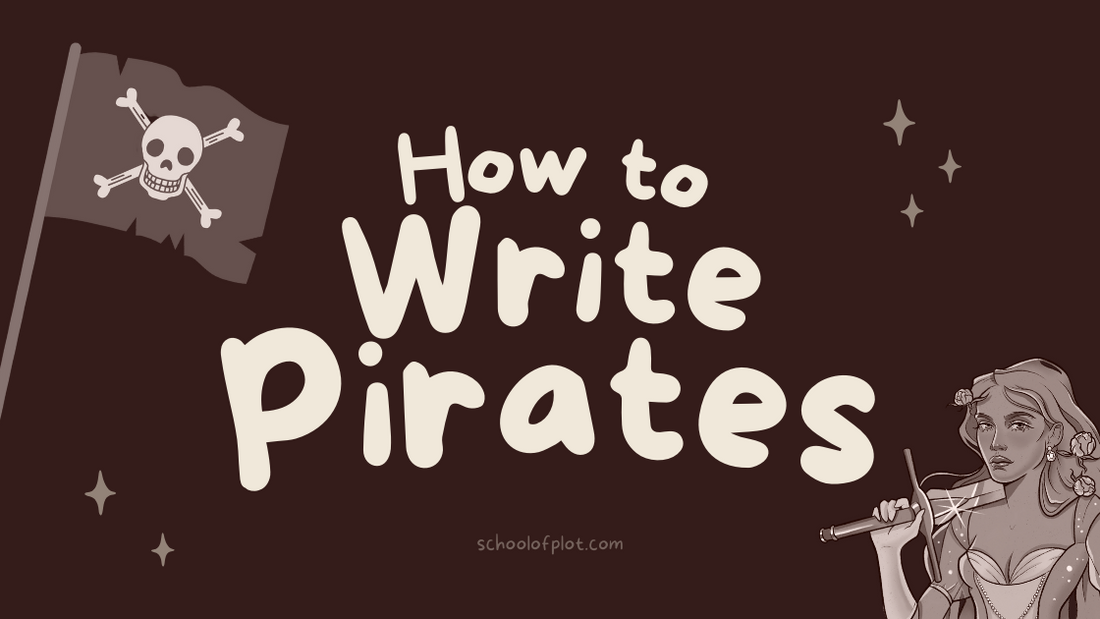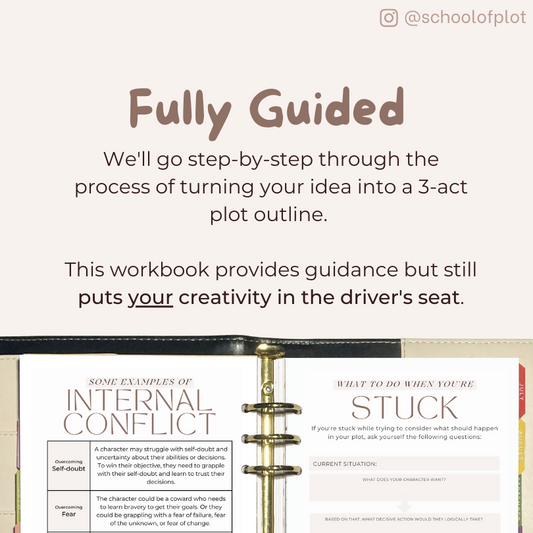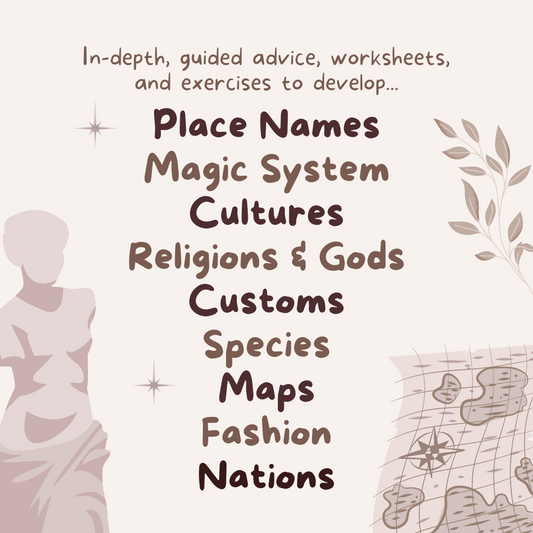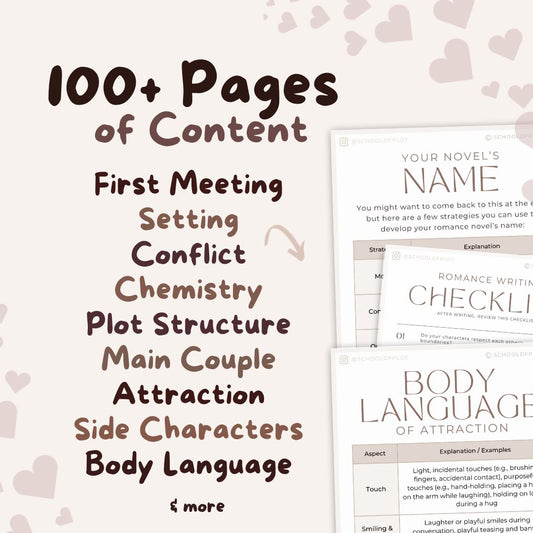If you're writing a story aboard a pirate ship, or featuring pirates, this guide will help you out with research. We'll go through jobs on the ship, weapons, terms, ship parts, and some common tropes of pirate stories.
Table of Contents
Roles on a Ship
- Pirate Captain
- Quartermaster: Second-in-command
- Helmsman: Steers the ship
- Boatswain: In charge of equipment and the crew.
- Gunner: Loads, aims, and fires canons
- Navigator: Plots the ship's course
- Lookout: Keeps watch from crow's nest
- Cook: Not a professional chef but a crew member who prepares meals
- Surgeon: Provides medical care. Again, often just a crew member
- Deckhands: General crew members who assist in various tasks, such as raising and lowering sails, handling lines, and performing maintenance duties.
Pirate Weapons
- Small Sword: A one-handed sword popular among European pirates during the 'Golden Age of Piracy.' Designed for thrusting, it required skill to wield effectively, although it could break if used against a heavier blade.
- Spadroon: A light, straight-bladed sword with a beaded or "five-ball" hilt. Popular among military and naval officers in the late 18th century, it was used for slashing and thrusting, with some variations being double-edged.
- Cutlass: A pirate weapon with a two-foot, slightly curved or straight single-edged blade. Known for its strength in cutting through ropes, canvas, and foes, the cutlass was ideal for hand-to-hand combat on ships.
- Rapier: A straight-bladed sword, longer than a small sword, primarily used for dueling. While its popularity waned by the late 17th century, some skilled pirates, especially Spaniards, may have still preferred it for personal combat.
- Cavalry & Broadsword: Weighing around four pounds with a length of about forty inches, these swords had either straight heavy blades with double edges or slightly curved blades. While challenging to use efficiently aboard ships, they could be adapted for shipboard service.
- Dagger & Dirk: A small, concealable knife, weighing between one and two pounds, used for various purposes such as cutting rope and as a last resort in close combat. The dirk was a specific type of small dagger, designed for throwing.
- Boarding Axe: Weighing around four pounds and two to three feet in length, the boarding axe was versatile for climbing, cutting rigging lines, and as a deadly hand-to-hand fighting tool during boarding.
- Blunderbuss: A close-range firearm with a large bore, firing a cluster of projectiles. Weighing between ten and sixteen pounds and two to three feet in length, it was effective in the confined spaces of a ship.
- Musket: A long-range firearm, weighing between twelve and eighteen pounds and four to five feet long. Used for sniping in calm conditions before boarding.
- Flintlock Pistol: A small, single-shot pistol with a flintlock firing mechanism, used by pirates for personal defence and boarding. Reloading was time-consuming, leading pirates to carry multiple pistols into battle.
- Cannon: Ship-mounted guns of various sizes and types, firing different shot types. Used in broadside attacks, they ranged from small 2-pounders to large 24-pounder ship wreckers.
Pirate Terminology
- Abaft: Toward the stern, relative to some object ("abaft the fore hatch").
- Adrift: Afloat and unattached in any way to the shore or seafloor, but not under way.
- Aground: Resting on or touching the ground or sea bottom, usually involuntarily.
- Batten down the Hatches: To prepare for inclement weather by securing hatch covers with battens.
- Beaching: Deliberately running a vessel aground to load and unload or prevent sinking.
- Careen: To take a ship into shallower waters to remove barnacles
- Coffer: A chest in which treasure can be kept
- Come About: To bring the ship full way around in the wind
- Crow's Nest: A small platform near the top of a mast, where a lookout was positioned
- Deadlights: Shutters or plates over a ship's porthole during a storm
- Fire In The Hole: A warning yelled before a cannon shot
- Gangplank: A big board or ramp placed between a ship and a pier for crossing over.
- Gunwalls: The sides of the top deck with openings for heavy arms or guns.
- Halyard: A rope used for raising or lowering a sail.
- Hull: The main body of a ship, excluding masts and superstructure.
- Headway: The forward motion of a ship through the water.
- Heave-To: To bring a ship to a stop by arranging the sails and rudder in a special way.
- Helm: The wheel or tiller controlling the ship's direction.
- Inboard: Inside the ship's hull.
- Isobar: A line on a weather map connecting points of equal atmospheric pressure.
- Irons: When a ship is directly into the wind and unable to make headway.
- Inshore: Toward the shore or closer to the land.
- Icing: The accumulation of ice on a ship's surfaces, often in cold weather.
- Jury Rigging: Temporary or makeshift rigging, often done in emergency situations.
- Jetty: A structure extending from the shore into the water to direct currents or protect a harbor.
- Jettison: To throw goods overboard to lighten a ship in distress.
- Keel: The main structural member of a ship, running lengthwise along the centerline at the bottom of the hull.
- Knot: A unit of speed equal to one nautical mile per hour.
- Knockdown: A sudden gust of wind causing a ship to lean over on its side
- Knotmeter: An instrument for measuring a ship's speed through the water.
- Lee: The side sheltered from the wind.
- Lubber's Line: A reference line on a compass indicating the ship's heading.
- Masthead: The top of a ship's mast.
- Mooring: The act of securing a ship in a particular location using anchors or lines.
- Overtopping: When waves break over a ship's deck.
- Poop Deck: A deck that is the roof of a cabin built in the aft part of the ship.
- Pintle: A pin or bolt on which something turns, such as a rudder.
- Privateer: A privately owned ship commissioned by a government to capture enemy vessels.
- Purser: An officer on a ship in charge of financial accounts and passenger arrangements.
- Quarterdeck: The part of the upper deck of a ship reserved for officers.
- Rigging: The system of ropes, chains, and tackle used to support and control the masts, sails, and yards of a sailing vessel.
- Rudder: A flat piece hinged vertically near the stern of a boat or ship, used for steering.
- Upwind: In the direction from which the wind is blowing.
- Weigh Anchor: To haul the anchor up; more generally, to leave port.
Pirate Ship Parts
- Hull: The main body of the ship, including the outer sides and bottom.
- Gangway: Movable walkway used for boarding or disembarking a ship.
- Mast: Vertical poles supporting the sails.
- Sails: Attached to the masts, they catch the wind to propel the ship.
- Rigging: Network of ropes and cables used to control the sails and masts.
- Captain's Cabin: The private quarters of the ship's captain.
- Galley: The ship's cooking area.
- Hold: The storage area below the main deck where cargo, supplies, or captured goods were stowed.
- Deck: The horizontal surfaces or levels of the ship.
Common Tropes in Pirate Novels
- Captured Princess: A noblewoman or princess who finds herself captured by pirates
- Pirate King/Queen: A legendary figure or elected leader who commands respect and holds power over a fleet of pirates.
- Found family: The real treasure was the friends we made along the way
- Princess and Captain: A romance between a pirate and a member of the establishment, such as a princess, nobleman/woman, or naval officer.
- Sworn Rivals: Two people (often rival captains) who share a bitter enmity
Pirate Writing Playlist
Common Settings in Pirate Novels
Common settings you can use in your pirate setting include the following:
- Docked Pirate Ship
- Port Town
- Tavern
- Hidden Island
- Treasure Cave
- Naval Warship
- Smuggler's Den
- Shipwreck
- Pirate Stronghold
- Royal Court
- Jungle or Rainforest
- Prison or Dungeon
- Open Ocean
- Pirate Fortress
- Ghost Ship
- Underwater World
Sources and Further Reading
- https://brethrencoast.com/Pirate_Glossary.html
- https://sdmaritime.org/visit/public-events/pirates/privateers/
- https://www.smithsonianmag.com/history/real-republic-pirates-180962444/
- https://www.history.com/topics/exploration/pirates











